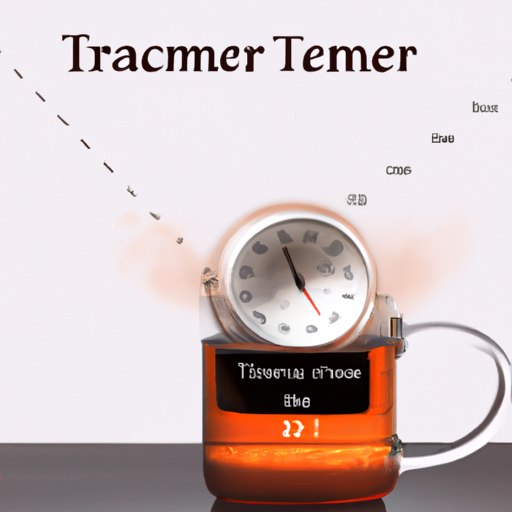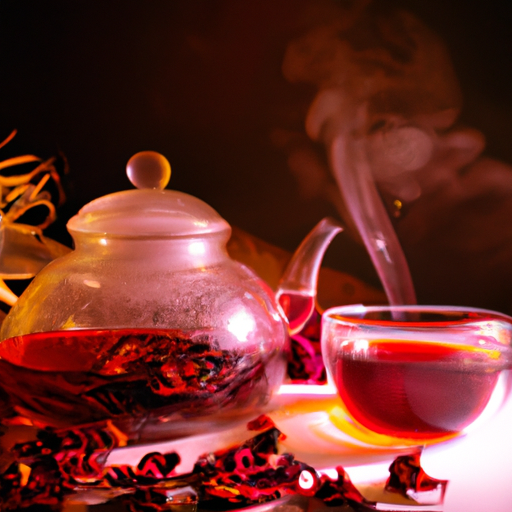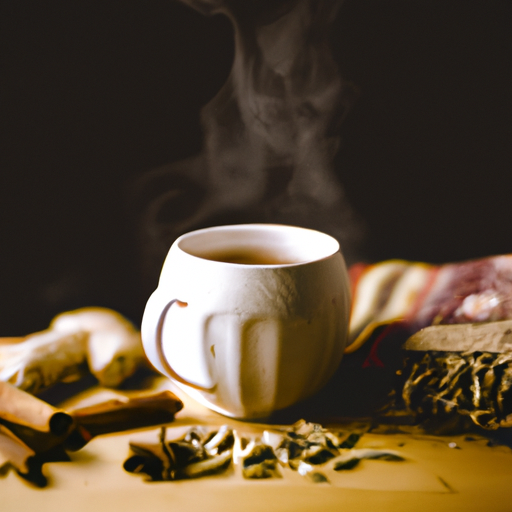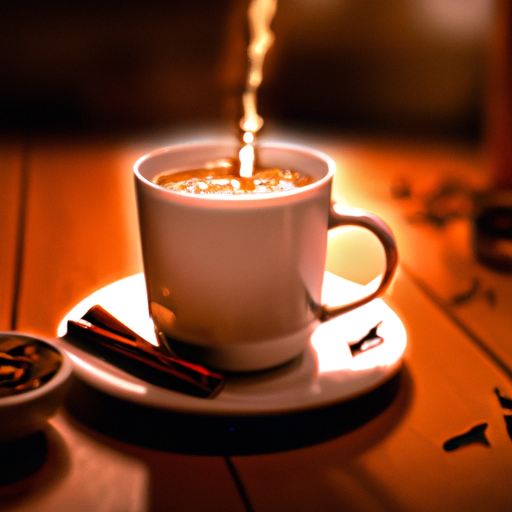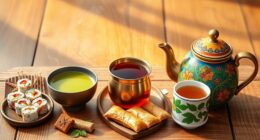As someone who adores tea, chai tea ranks high on my list of preferred blends. Its combination of hearty spices and full flavors offers the ideal drink for a cold day or as a mid-afternoon boost. Nevertheless, for newcomers to this delightful drink, determining the appropriate steeping time for chai tea can be perplexing.
Steeping time is crucial in bringing out the full flavor and aroma of your chai tea blend. Steep too little, and you risk not fully extracting all the flavors; steep too long, and you could end up with a bitter or over-steeped brew.
In this article, I will guide you through the process of properly steeping your chai tea so that you can enjoy its full potential with every sip.
Key Takeaways
- Steeping time and temperature are crucial factors for optimal flavor and aroma extraction in chai tea.
- Measuring accuracy is important for both tea leaves and spices to achieve desired flavor and balance.
- Choosing the right tea leaves (loose leaf black tea) and using filtered or bottled water can enhance the quality of chai tea.
- Adding frothed milk and garnishes can elevate the flavor and overall experience of drinking chai tea.
Understanding the Basics of Chai Tea
To truly grasp the fundamentals of chai tea, it’s essential to comprehend the intricacies of its brewing process, including how long to steep it. Understanding the flavor profile is key in knowing how long to steep chai tea.
Chai tea is a blend of black tea and spices such as cinnamon, cardamom, ginger, and cloves. These spices can be overwhelming if steeped too long, so it’s crucial to find a balance that will bring out their flavors without overpowering the black tea base.
Aside from its delicious taste, there are also health benefits of drinking chai tea. The combination of black tea and spices creates a powerful antioxidant-rich beverage that can help boost immunity and reduce inflammation. Additionally, some studies have shown that drinking chai tea may help lower cholesterol levels and regulate blood sugar.
Choosing the right tea leaves is an important step in brewing the perfect cup of chai. It’s best to use loose leaf black tea since it has larger leaves than bagged teas which allows for better infusion with spices. Once you have your desired amount of loose leaf black tea and spices mixed together, steep them in hot water for 3-5 minutes depending on personal preference before adding milk or sweetener.
Now that we understand the basics of chai tea brewing process including understanding its flavor profile and health benefits along with choosing the right type of leaves, let’s move on to other tips for making this beloved drink at home.
Choosing the Right Tea Leaves
Selecting the perfect tea leaves is like picking out a stylish outfit for your taste buds. It all starts with choosing the right tea grades, which can range from whole leaf to dust.
Whole leaf teas are considered the highest quality and are made up of full, intact leaves that have been carefully handpicked and processed. Meanwhile, broken leaf teas are still high in quality but consist of smaller pieces of leaves that were damaged during processing.
When selecting tea blends, it’s important to consider both flavor and aroma. Some popular chai tea blends include black tea with spices such as cinnamon, cardamom, ginger, clove, and black pepper. However, there are also green and white tea-based chai blends available that offer a lighter taste profile.
Another factor to consider when choosing tea leaves is the origin of the tea. For example, Indian Darjeeling or Assam teas may provide more traditional flavors in chai blends due to their distinct terroir. Meanwhile, Chinese black teas or Japanese green teas can offer unique flavor profiles that add complexity to your blend.
Selecting the perfect tea leaves for your chai blend requires consideration of factors such as grade (whole leaf or broken leaf), blend (black vs green/white), and origin (Indian vs Chinese/Japanese). Once you’ve chosen your desired blend and prepared your loose-leaf tea accordingly using boiling water and steep time recommendations specific to your blend, it’s time to enjoy!
Preparing Your Tea Leaves
When preparing chai tea, the perfect amount of tea leaves is crucial for achieving the right balance of flavors. I usually measure out one tablespoon of loose tea leaves per cup of water.
Next, I add a variety of spices such as cardamom, cinnamon, and ginger to enhance the aroma and taste.
Finally, adding milk (dairy or non-dairy) not only mellows out the strong flavor but also adds creaminess to the overall texture.
Make sure to use contractions.
Measuring the Perfect Amount
Achieving the perfect cup of chai tea starts with accurately measuring out the right amount of tea leaves and spices. Measuring accuracy is crucial since too much or too little can throw off the flavor balance. It’s important to follow a recipe or guideline to ensure that you’re using the correct measurements for your desired taste.
When measuring your chai ingredients, it’s best to use a kitchen scale instead of volume measurements like tablespoons. This way, you can be sure that you’re using an accurate amount of each ingredient.
After weighing out your black tea leaves, cinnamon sticks, cardamom pods, cloves, ginger root, and black peppercorns according to your recipe, mix them together in a bowl and store them in an airtight container until ready to brew.
Now that you have measured out your ingredients correctly, it’s time to move on to adding spices and milk for brewing your perfect cup of chai tea without altering its taste profile.
Adding Spices and Milk
To create a rich and flavorful cup, simply add your spice blend and milk to the water as it’s boiling. Adding spices is key to making a delicious chai tea that’s full of flavor. You can use cardamom, cinnamon, ginger, cloves, or any combination of these spices to create a unique taste that’s tailored to your liking.
Once you’ve added your spice blend to the water, let it simmer for about 5-10 minutes until the flavors have fully infused.
After adding the spices, frothing milk is another great way to enhance your chai tea experience. Frothed milk adds a creamy texture that compliments the boldness of the spices in the tea. To froth milk at home, heat up some milk in a saucepan until it starts steaming then pour it into a blender and blend on high speed until it becomes frothy.
Add this frothed milk to your chai tea and enjoy!
Moving onto heating the water, I always prefer using filtered water for better taste quality.
Heating the Water
First, you’ll need to fill your kettle with fresh water and bring it to a boil on the stove or in an electric kettle. It’s important that the water reaches boiling temperature for proper steeping of your chai tea. The ideal temperature range for brewing black tea, which is used as the base for chai, is between 195°F and 205°F (90°C – 96°C). Too hot or too cold water can affect the taste of your tea.
Additionally, water quality also plays a crucial role in achieving a perfect cup of chai. Using filtered or bottled water ensures that there are no impurities or chemicals present in the water that can alter the flavor of your tea. Hard water with high mineral content can make your tea taste bitter and hard on the palate. By using clean and fresh-tasting water, you’ll be able to fully enjoy all the flavors of your chai.
Heating up fresh and clean-tasting water to boiling temperature is crucial for preparing a delightful cup of chai. Remember to use filtered or bottled water if possible to avoid any unwanted minerals in your brew that may ruin its taste. Once you’ve heated up your water, it’s time to move onto steeping your chai tea by adding it into hot liquid along with aromatic spices such as cinnamon, cardamom, ginger, and cloves for an unforgettable experience!
Steeping Your Chai Tea
When it comes to steeping chai tea, timing and temperature are crucial factors.
I usually wait for about 5-7 minutes after pouring boiling water over the tea bag or loose leaves, but this may vary depending on personal preferences.
It’s important to cover your tea while it steeps to prevent heat from escaping and maintain consistent temperature.
Additionally, stirring and checking can help ensure that your chai is steeped just right.
Timing and Temperature
The perfect cup of chai tea requires careful attention to timing and temperature, ensuring a rich and flavorful brew every time. When it comes to steeping your chai tea, the duration and water temperature are two crucial factors that can greatly affect the taste of your final product. For optimal results, steep your chai tea for 4-5 minutes in boiling water that has been allowed to cool slightly.
To help you nail down the perfect steeping time and temperature for your personal preferences, consider using this table as a guide:
| Steeping Duration | Water Temperature | Flavor Profile |
|---|---|---|
| 2-3 minutes | 170°F – 180°F | Light |
| 4-5 minutes | 190°F – 200°F | Medium |
| 6+ minutes | Boiling (212°F) | Strong |
By keeping these guidelines in mind and adjusting them based on personal preference, you can create a delicious cup of chai tea that perfectly suits your tastes. But before we move on to covering our tea, it’s important to note that steeping too long or at too high of a temperature can result in a bitter or unpleasant taste. So be sure to experiment with different times and temperatures until you find what works best for you!
Covering Your Tea
In order to achieve the perfect cup of chai tea, timing and temperature are crucial factors. However, there is one more element that can make a significant difference in the final product: covering your tea.
Using a tea cozy or other covering techniques for steeping chai tea can help maximize flavor extraction while preventing heat loss. Here are some tips for covering your chai tea during steeping:
- Use a lid on your teapot or mug to trap heat.
- Wrap a towel or cloth around your teapot to insulate and keep the heat in.
- Use a tea cozy specifically designed for keeping your teapot warm during steeping.
By implementing these covering techniques, you can ensure that all the complex flavors and spices in your chai blend are fully extracted from the leaves. This will result in a richer, more satisfying cup of tea.
As we move forward with our discussion on how long to steep chai tea, it’s important to note that stirring and checking on your brew is also an essential step in achieving optimal flavor extraction.
Stirring and Checking
To achieve the perfect cup of chai, don’t forget to stir and check on your brew regularly for optimal flavor extraction. The importance of patience can’t be overstated when steeping tea.
Steeping too short can result in a weak and underdeveloped flavor while steeping too long can make the tea bitter. Therefore, it’s essential to find the right balance between time and intensity.
Different steeping techniques can also affect the overall taste of your chai. Some people prefer to simmer their tea on low heat for an extended period, while others choose to bring their water to a boil before adding the tea leaves and spices. Experiment with different methods until you find what works best for you.
Once you’ve achieved the ideal brewing time and technique, you’re ready to move onto adjusting the flavors in the subsequent section without compromising your hard work so far.
Adjusting the Flavors
When steeping chai tea, don’t be afraid to play with the spices and adjust them to your liking. Chai tea is known for its unique blend of spices such as cinnamon, cardamom, ginger, and cloves. However, the ratio of these spices can vary depending on personal preference. If you prefer a stronger cinnamon taste or a spicier kick from the ginger and cloves, then feel free to tweak the spice levels accordingly.
Adjusting sweetness is another important factor when making chai tea. Traditionally, chai tea is made with milk and sweetened with sugar or honey. However, some may find this too sweet or not sweet enough. To adjust the sweetness level in your chai tea, try using different types of sweeteners such as maple syrup or stevia. You can also adjust the amount of sweetener used by adding more or less depending on your taste buds.
Once you have adjusted the flavors to your liking, it’s time to strain your tea. This step ensures that any loose leaves or spices are removed before drinking. To strain your chai tea, simply pour it through a fine mesh strainer into a cup or teapot.
Now that your deliciously flavored chai tea is ready to drink, sit back and enjoy every sip!
Straining Your Tea
Now that you’ve adjusted the flavors of your chai tea to your liking, it’s time to move on to the next step: straining. Straining is an important part of the steeping process as it removes any loose debris or spices from your tea, resulting in a smoother and cleaner taste.
There are various straining techniques you can use depending on your preference and available tools. One common method is using a fine mesh strainer to catch any solids while pouring the tea into a cup or teapot. Another option is using cheesecloth or a tea sock, which allows for more precise filtering of small particles and spices.
It’s important to avoid squeezing the bag or cloth too hard as this can release bitter tannins into your tea. To make the process easier, investing in some tea accessories such as a good quality strainer or infuser can go a long way in achieving the perfect cup of chai. These items not only make straining simpler but also reduce waste by allowing you to reuse loose leaf tea instead of relying on pre-packaged bags.
With your chai now strained and ready for consumption, it’s time to move onto serving. Whether it be hot or iced, there are many ways to enjoy this delicious beverage with friends and family alike.
Serving Your Chai Tea
When it comes to serving chai tea, there are a few key details to consider. First, choosing the right cup can enhance the overall experience.
Next, adding garnishes such as cinnamon or cardamom can add an extra layer of flavor and visual appeal.
Finally, pairing chai tea with snacks like cookies or pastries can create a well-rounded and satisfying treat. As someone who loves indulging in a warm cup of chai, I’ve learned that paying attention to these small details can make all the difference in enjoying this beloved drink.
Choosing the Right Cup
Choosing the right cup for your chai tea can greatly enhance the flavor and aroma, so it’s important to consider factors like size, shape, and material. A good cup should be able to hold enough liquid to accommodate the amount of tea you want without being too large or small.
Additionally, a wide opening at the top will allow for better aroma diffusion while sipping. It’s also essential to choose a cup that can maintain temperature control. Porcelain and ceramic cups are excellent options because they are great heat insulators, keeping your chai hot for longer periods.
On the other hand, glass cups are perfect if you want to admire the rich color of your tea as it steeps. Choosing an appropriate cup is crucial because it can positively affect how much you enjoy your tea drinking experience. With this in mind, let’s explore adding garnishes to our delicious chai tea!
Adding Garnishes
To elevate your chai tea experience, amp up the flavor by adding a garnish that suits your taste buds. Garnishing options for chai tea are endless and can really take your cup to the next level.
Here are two sub-lists of flavor combinations that you might want to try:
-
Spices: Add a pinch of cinnamon or nutmeg on top of your chai latte for a warm and cozy touch. You can also sprinkle some cardamom seeds or cloves for an extra burst of flavor.
-
Fruits: If you prefer a fruity twist, add fresh berries such as raspberries or blueberries on top of your iced chai tea. For a tropical vibe, slice some mangoes or pineapples and garnish them on top.
Experiment with different flavors until you find the perfect combination that suits your taste buds. Once you’ve found it, pair it with some delicious snacks such as cookies or cakes to create an even more indulgent experience.
Pairing with Snacks
Enhance your chai tea experience by indulging in some delicious snacks that complement its flavors perfectly. Pairing suggestions for chai tea include sweet and savory treats, such as cookies, pastries, nuts, and cheeses.
For a sweet pairing option, try dipping a freshly baked cookie into your hot chai tea to balance out the spices with a touch of sweetness. Alternatively, pair your chai tea with a slice of creamy cheesecake or chocolate cake to create an indulgent dessert experience.
If you’re looking for something on the savory side, consider trying a cheese plate with flavorful options like aged cheddar or brie. The creamy texture of cheese pairs well with the bold spices in chai tea. Additionally, nuts like almonds or pistachios make for a satisfying snack that can also enhance the earthy notes in your cup of chai.
Experiment with different flavor combinations to find what works best for you and enjoy the perfect pairing alongside your favorite cup of chai tea.
To ensure that you always have fresh tasting chai tea on hand to enjoy with your favorite snacks, it’s important to know how to properly store it.
Storing Your Chai Tea
When it comes to storing my chai tea, I always make sure to keep it fresh by using air-tight containers. This helps prevent moisture and light from seeping in and destroying the flavor of my tea.
By taking these simple steps, I can ensure that every cup of chai I make is just as delicious as the first time I brewed it.
Keeping Your Tea Fresh
You want to make sure your chai tea stays as fresh as a crisp autumn day, so keep it in an airtight container away from any strong scents or sunlight. Storing techniques play an important role in maintaining the quality of your tea and extending its shelf life. Here are some tips on how to keep your chai tea fresh:
-
Use air-tight containers: Airtight containers prevent moisture and air from getting into the container, which can cause your tea to lose its flavor and aroma quickly. Make sure the lid seals tightly to ensure that no air can get in.
-
Glass jars with rubber seals or metal lids work well.
-
Avoid plastic containers as they may contain chemicals that can leach into your tea.
-
Store in a cool, dark place: Heat and light can degrade the quality of your chai tea by breaking down its compounds. Keep it in a cool, dark place like a pantry or cupboard.
By following these simple storage tips, you’ll be able to enjoy fresh and flavorful chai tea for longer periods. Using air-tight containers is just one way to maintain freshness; next, we’ll delve into how long you should steep your chai tea for maximum flavor extraction.
Using Air-Tight Containers
In the previous subtopic, I discussed the importance of keeping your tea fresh. One way to do this is by using air-tight containers. By sealing your tea in an air-tight container, you can prevent oxygen and moisture from getting in and damaging the quality of your tea.
Using air-tight containers is especially important for Chai tea, which has a combination of spices that are prone to losing their aroma and flavor over time. To emphasize the significance of using air-tight containers, let’s take a look at this table:
| Tea Storage | Air-Tight Container | Loose Bag |
|---|---|---|
| Freshness | 5/5 | 3/5 |
| Aroma Retention | 5/5 | 3/5 |
| Flavor Retention | 5/5 | 3/5 |
| Moisture Protection | 5/5 | 2/5 |
| Oxidation Prevention | 4/5 | 1/5 |
As you can see, an air-tight container scores much higher than a loose bag in terms of freshness, aroma retention, flavor retention, moisture protection and oxidation prevention. Therefore, it’s crucial to store your chai tea in an air-tight container to keep it fresh for longer periods.
To continue with our discussion on preserving chai tea quality, next we will talk about avoiding moisture and light exposure when storing your chai tea.
Avoiding Moisture and Light
To keep your chai tea at its best, it’s essential to protect it from moisture and light exposure. Preventing spoilage and preserving flavor are the key goals when storing chai tea.
Moisture can cause mold growth, while light can break down the delicate flavors of the tea leaves over time. Here are some tips for storing your chai tea:
- Use airtight containers: This will help prevent any air or moisture from getting to your chai tea.
- Store in a cool, dark place: Heat and sunlight can also affect the quality of your chai tea, so store it in a place away from direct sunlight or heat sources.
- Avoid storing near strong smells: Chai tea can easily absorb other odors around it, so keep it away from strong-smelling items like spices or cleaning products.
- Don’t store for too long: Even with good storage practices, chai tea is best consumed within 6 months to ensure optimal flavor.
Overall, taking care of your chai tea by keeping it away from moisture and light will help preserve its flavor for longer. Now let’s move on to experimenting with different ways to steep and enjoy this delicious beverage.
Experimenting with Chai Tea
Gotta admit, playing around with different spices in my chai tea has been a fun experiment. I’ve always loved the warm and comforting taste of traditional chai tea, but recently I’ve been trying to mix things up by adding different spices to create unique blends. I’ve found that experimenting with cardamom, cinnamon, ginger, cloves, and black pepper can really take my chai tea to the next level.
In addition to trying different spices, I’ve also been exploring different steeping methods. For example, instead of using boiling water like traditional chai recipes suggest, I sometimes use warm milk as the base for my tea. This creates a creamier texture and adds an extra layer of richness to the flavor.
Another method is cold brewing which involves soaking the tea leaves in cold water for several hours or overnight. The result is a smoother and less bitter taste.
Overall, experimenting with chai tea has been a delicious journey of discovery for me. By trying new spice combinations and steeping methods, I’ve learned how subtle changes can make a big difference in flavor. It’s exciting to know that there are endless possibilities when it comes to creating your own perfect cup of chai tea!
Frequently Asked Questions
What are the health benefits of chai tea?
Chai tea is known for its many health benefits, including its antioxidant properties. It contains a blend of spices such as cinnamon, ginger, cardamom, and cloves, which are all rich in antioxidants that help fight inflammation. These spices also aid in digestion and can help alleviate nausea and bloating.
Additionally, the black tea base of chai tea provides caffeine to boost energy levels and improve mental alertness. Regular consumption of chai tea has been linked to lower risk of heart disease and may even improve cholesterol levels.
Overall, incorporating chai tea into your diet can provide numerous health benefits while also offering a deliciously spicy flavor.
Can I use alternative milks, such as almond or soy, in my chai tea?
Yes, you can definitely use alternative milks in your chai tea. Some of the best alternatives include almond milk and soy milk. When it comes to proper measurements, it’s important to note that different milks may require varying amounts depending on their thickness and consistency. For example, if using almond milk, a little bit less than the usual amount of regular milk may be needed to achieve the desired taste and texture.
It’s all about experimenting and finding what works best for you. Overall, incorporating alternative milks into your chai tea is a great way to add some variety and cater to specific dietary needs or preferences.
How can I make a decaf version of chai tea?
Wow, making a decaf version of chai tea is easier than I thought! First, I simply swap out regular black tea for a decaf version.
Then, I can still enjoy the delicious spices by using cinnamon sticks, ginger root, cardamom pods, and cloves to create my own spice blend. If you want to go even further with your spices substitution, try adding some star anise or fennel seeds for a unique twist.
The key is to simmer the spices in the milk (I like to use almond or soy milk) for at least 10 minutes before adding the decaf tea and letting it steep for another 5-7 minutes.
The result? A warm and cozy Decaf Chai that will satisfy any craving without keeping you up all night.
Are there any specific spices that are essential for making chai tea?
When it comes to making chai tea, there are definitely some essential spices that you’ll need. These include ginger, cardamom, cinnamon, cloves, and black pepper. Depending on the variation of chai you’re making, you may also want to add in other spices like fennel seeds or star anise.
When I make my own chai tea at home, I always start with a base of black tea. Then, I add in these essential spices (and any additional ones) while simmering on the stove for about 10-15 minutes. This allows all of the flavors to meld together and create that deliciously complex taste that we all know and love from a good cup of chai.
Can I reuse my chai tea leaves for a second steeping?
I’ve found that reusing chai tea leaves is definitely possible, but the flavor quality won’t be as strong as the first steeping. The reuse potential of chai tea leaves depends on how long they were steeped for in the first place. If you only steeped them for a short time, then a second round of steeping might still result in a flavorful cup. However, if you let your chai tea steep for an extended period of time (which isn’t recommended), then the flavor will already have been extracted from the leaves and there won’t be much left to draw out during a second infusion.
Overall, while I don’t think it’s necessary to throw away your used chai tea leaves after just one use, it’s also important to note that their flavor profile will likely be weaker with each subsequent use.
Conclusion
In conclusion, steeping chai tea is an art form that requires patience and attention to detail. As a tea lover myself, I’ve experimented with various brewing techniques to find the perfect cup of chai.
One time, I was in a rush and tried to speed up the steeping process by using boiling water instead of hot water. The result was bitter and overpowering, reminding me of trying to force a flower to bloom before it’s ready.
Just like a flower needs time to grow and blossom, so does our cup of chai tea. Taking the time to choose quality tea leaves, heating the water correctly, and allowing for proper steeping will ultimately lead to a delicious and satisfying experience.
So next time you make yourself a cup of chai tea, remember that good things come to those who wait – or in this case, those who patiently let their tea steep.

